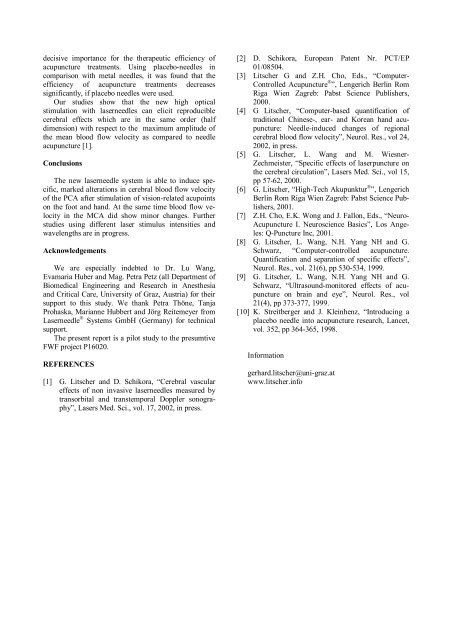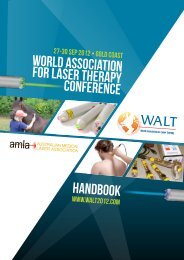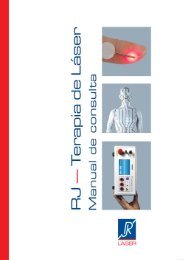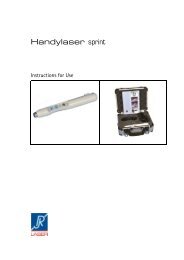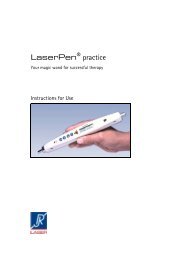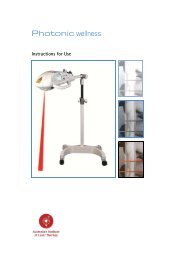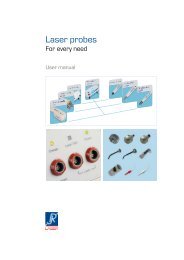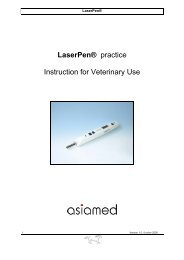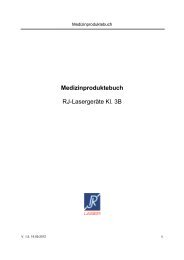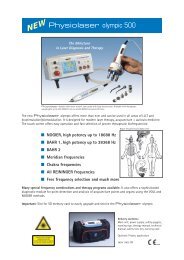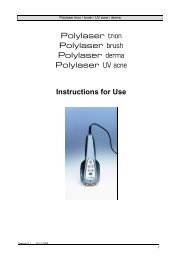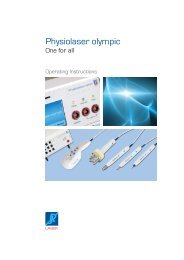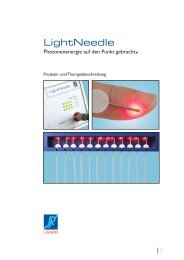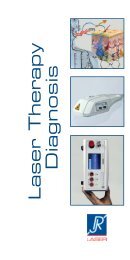LightNeedle - RJ Laser
LightNeedle - RJ Laser
LightNeedle - RJ Laser
Create successful ePaper yourself
Turn your PDF publications into a flip-book with our unique Google optimized e-Paper software.
decisive importance for the therapeutic efficiency of<br />
acupuncture treatments. Using placebo-needles in<br />
comparison with metal needles, it was found that the<br />
efficiency of acupuncture treatments decreases<br />
significantly, if placebo needles were used.<br />
Our studies show that the new high optical<br />
stimulation with laserneedles can elicit reproducible<br />
cerebral effects which are in the same order (half<br />
dimension) with respect to the maximum amplitude of<br />
the mean blood flow velocity as compared to needle<br />
acupuncture [1].<br />
Conclusions<br />
The new laserneedle system is able to induce specific,<br />
marked alterations in cerebral blood flow velocity<br />
of the PCA after stimulation of vision-related acupoints<br />
on the foot and hand. At the same time blood flow velocity<br />
in the MCA did show minor changes. Further<br />
studies using different laser stimulus intensities and<br />
wavelengths are in progress.<br />
Acknowledgements<br />
We are especially indebted to Dr. Lu Wang,<br />
Evamaria Huber and Mag. Petra Petz (all Department of<br />
Biomedical Engineering and Research in Anesthesia<br />
and Critical Care, University of Graz, Austria) for their<br />
support to this study. We thank Petra Thöne, Tanja<br />
Prohaska, Marianne Hubbert and Jörg Reitemeyer from<br />
<strong>Laser</strong>needle ® Systems GmbH (Germany) for technical<br />
support.<br />
The present report is a pilot study to the presumtive<br />
FWF project P16020.<br />
REFERENCES<br />
[1] G. Litscher and D. Schikora, “Cerebral vascular<br />
effects of non invasive laserneedles measured by<br />
transorbital and transtemporal Doppler sonography”,<br />
<strong>Laser</strong>s Med. Sci., vol. 17, 2002, in press.<br />
[2] D. Schikora, European Patent Nr. PCT/EP<br />
01/08504.<br />
[3] Litscher G and Z.H. Cho, Eds., “Computer-<br />
Controlled Acupuncture ® ”, Lengerich Berlin Rom<br />
Riga Wien Zagreb: Pabst Science Publishers,<br />
2000.<br />
[4] G Litscher, “Computer-based quantification of<br />
traditional Chinese-, ear- and Korean hand acupuncture:<br />
Needle-induced changes of regional<br />
cerebral blood flow velocity”, Neurol. Res., vol 24,<br />
2002, in press.<br />
[5] G. Litscher, L. Wang and M. Wiesner-<br />
Zechmeister, “Specific effects of laserpuncture on<br />
the cerebral circulation”, <strong>Laser</strong>s Med. Sci., vol 15,<br />
pp 57-62, 2000.<br />
[6] G. Litscher, “High-Tech Akupunktur ® ”, Lengerich<br />
Berlin Rom Riga Wien Zagreb: Pabst Science Publishers,<br />
2001.<br />
[7] Z.H. Cho, E.K. Wong and J. Fallon, Eds., “Neuro-<br />
Acupuncture I. Neuroscience Basics”, Los Angeles:<br />
Q-Puncture Inc, 2001.<br />
[8] G. Litscher, L. Wang, N.H. Yang NH and G.<br />
Schwarz, “Computer-controlled acupuncture.<br />
Quantification and separation of specific effects”,<br />
Neurol. Res., vol. 21(6), pp 530-534, 1999.<br />
[9] G. Litscher, L. Wang, N.H. Yang NH and G.<br />
Schwarz, “Ultrasound-monitored effects of acupuncture<br />
on brain and eye”, Neurol. Res., vol<br />
21(4), pp 373-377, 1999.<br />
[10] K. Streitberger and J. Kleinhenz, “Introducing a<br />
placebo needle into acupuncture research, Lancet,<br />
vol. 352, pp 364-365, 1998.<br />
Information<br />
gerhard.litscher@uni-graz.at<br />
www.litscher.info


